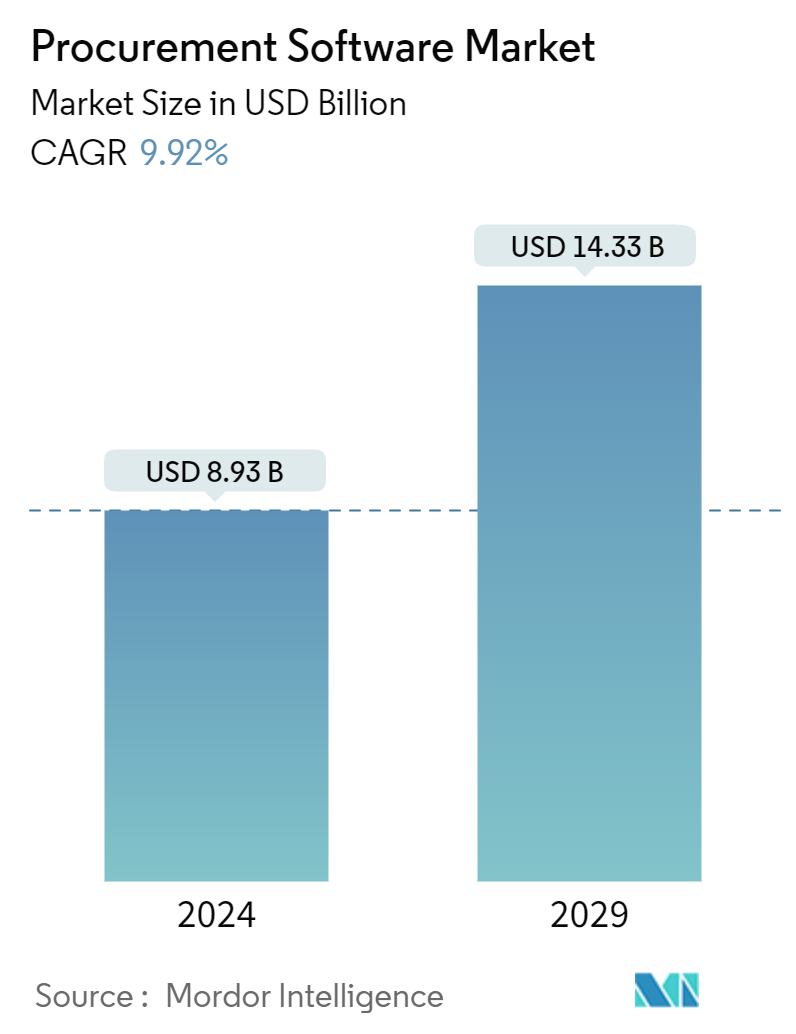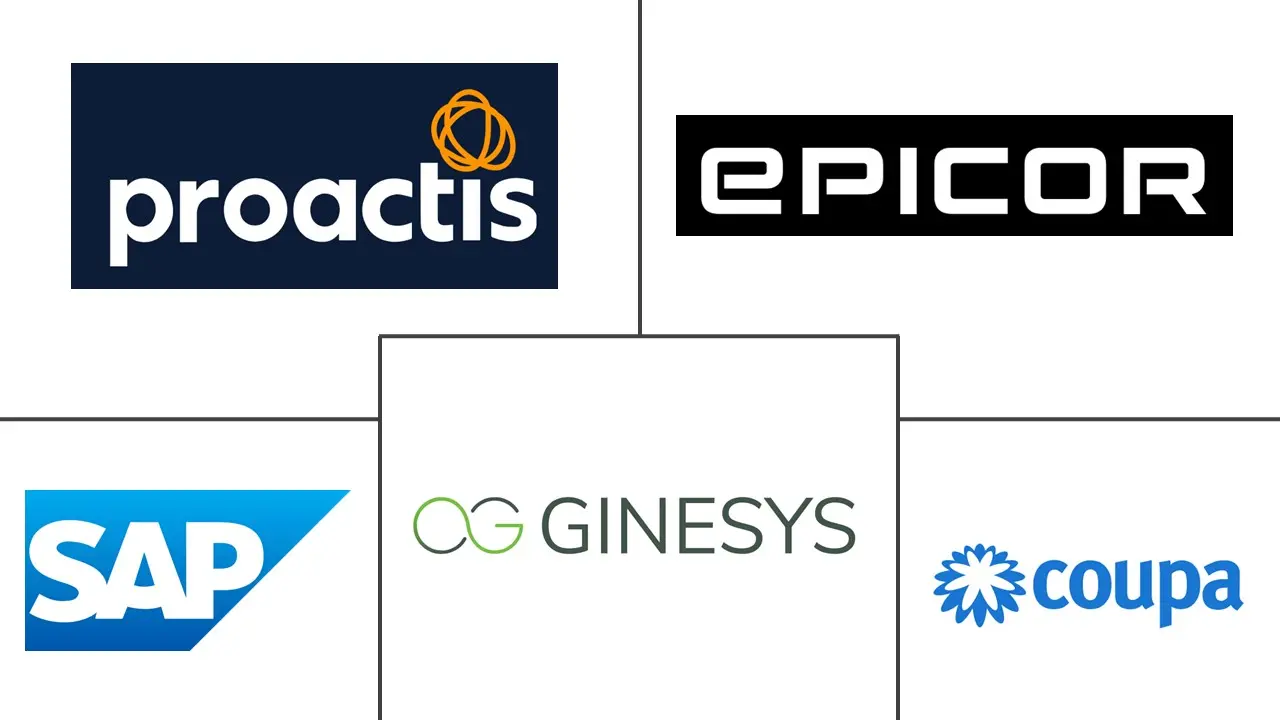Market Size of Procurement Software Industry

| Study Period | 2019 - 2029 |
| Market Size (2024) | USD 8.93 Billion |
| Market Size (2029) | USD 14.33 Billion |
| CAGR (2024 - 2029) | 9.92 % |
| Fastest Growing Market | Asia Pacific |
| Largest Market | North America |
| Market Concentration | Low |
Major Players
*Disclaimer: Major Players sorted in no particular order |
Procurement Software Market Analysis
The Procurement Software Market size is estimated at USD 8.93 billion in 2024, and is expected to reach USD 14.33 billion by 2029, growing at a CAGR of 9.92% during the forecast period (2024-2029).
Software companies are increasing their focus on in-demand technologies and re-exploring innovative ways to serve their clients. The primary factor driving the procurement software industry is the increased integration of developing technologies, such as artificial intelligence, which assists in high-quality reports and features to maintain accuracy.
- With the growing requirement to automate procurement procedures, the maturation of e-procurement technology is expected to offer new avenues for market growth during the forecast period. Furthermore, the need to prevent duplicate records is projected to drive the growth of the procurement software industry in the future. Moreover, the implementation of government policies encourages market development. The increase in the flow of foreign transactions across borders fuels the market's progress even further. The market synergy between supply and demand drivers is predicted to affect future market growth.
- There is a growing desire to automate procurement operations to improve efficiency and reduce time. It also expedites the process by relieving personnel of time-consuming and unneeded tasks. Procurement process automation is becoming increasingly popular, especially in buy requests, purchase orders, invoice management, vendor management, and contract approval.
- E-procurement software helps an organization integrate and automate its whole procurement process. ERP assists in easing supplier management by facilitating the procurement processes, freeing time to concentrate on other tasks, and enabling a more effective business, which is made possible when e-procurement tools are connected with ERP solutions. Among other things, ERP solutions support improved business reporting, better customer service, lower inventory costs, increased cash flow, cost reductions, data and cloud security, and supply chain management. These factors encourage market expansion.
- In September 2023, SAP SE, Bristol & Weston NHS Purchasing Consortium (BWPC) announced it had selected SAP Ariba to drive its digital procurement transformation program as it embraces a single modern procurement platform in the cloud.
- Further, in August 2023, one of South Africa’s leading global transport and logistics companies, Bidvest International Logistics, signed a multi-year agreement with Zycus, a cognitive procurement software provider, to transform its source-to-pay landscape with Zycus’ AI-powered solutions. A key goal for Bidvest was to enable faster invoice processing and optimize the entire PR to PO process, including lowering PO processing costs. The organization has hence selected the invoicing solution with e-procurement alongside Zycus’ AI-led accounts payable (AP) automation solution, which would also enable cost-efficient invoice processing, better supplier communications, dynamic discounting, and fraud detection, as well as help in achieving global compliance.
- The market for procurement software is expected to have challenges during the forecast period because many organizations lack the infrastructure necessary to work with traditional systems. On the contrary, the lack of skilled personnel impedes the market’s growth.
- The COVID-19 pandemic has accelerated the digital transformation of the procurement process and highlighted the importance of procurement software in enabling agility, resilience, and efficiency in supply chain management. As businesses continue to adapt to the evolving business landscape, the demand in the market is expected to grow. The post-COVID-19 landscape has reinforced the importance of procurement software in driving operational efficiency, risk mitigation, and strategic value creation for businesses.
Procurement Software Industry Segmentation
Procurement software is a program that consists of various features, such as helping in executing the online ordering process, generating the purchase order, matching the invoices to the materials received, and electronic payment of all the bills. It helps in increasing productivity, reduces external costs, spending controls, and process efficiencies, and generates electronic requests for proposal (e-RFP), electronic requests for information (e-RFI), and electronic requests for quotation (e-RFQ). Procurement software, along with e-procurement, helps in reducing the complete procurement life cycle.
The procurement software market is segmented by deployment (on-premise and cloud), end-user industry (retail, manufacturing, transportation and logistics, healthcare, and other end-user industries), and geography (North America, Europe, Asia-Pacific, and Rest of the World). The market sizes and forecasts are provided in terms of value (USD) for all the above segments.
| By Deployment | |
| On-premise | |
| Cloud |
| By End-user Industry | |
| Retail | |
| Manufacturing | |
| Transportation and Logistics | |
| Healthcare | |
| Other End-user Industries |
| By Geography | |
| North America | |
| Europe | |
| Asia | |
| Australia and New Zealand | |
| Latin America | |
| Middle East and Africa |
Procurement Software Market Size Summary
The procurement software market is poised for significant growth, driven by the increasing integration of advanced technologies like artificial intelligence, which enhances reporting accuracy and feature quality. The demand for automation in procurement processes is rising, as businesses seek to improve efficiency and reduce time spent on manual tasks. E-procurement technology is maturing, offering new growth opportunities by streamlining processes such as purchase orders, invoice management, and vendor interactions. The market is further bolstered by government policies promoting digital transformation and the need to manage cross-border transactions effectively. Despite challenges like infrastructure limitations and a shortage of skilled personnel, the market is expected to expand as organizations recognize the strategic value of procurement software in enhancing operational efficiency and risk management.
The retail industry is anticipated to be a major contributor to the procurement software market, as retailers strive to remain competitive amid rising costs and diminishing brand loyalty. By adopting procurement software, retailers can automate and streamline their procurement processes, improving transparency and efficiency in financial supply chains. The increasing digitization of business processes is driving the adoption of e-procurement solutions, which facilitate online purchasing and supplier collaboration. North America leads the market due to its focus on centralized procurement processes and regulatory compliance. The market is characterized by fragmentation, with both global players and SMEs competing through partnerships and acquisitions to enhance their offerings. Innovations in AI, machine learning, and data analytics are key to staying competitive and meeting evolving customer needs.
Procurement Software Market Size - Table of Contents
-
1. MARKET INSIGHTS
-
1.1 Market Overview
-
1.2 Industry Attractiveness - Porter's Five Forces Analysis
-
1.2.1 Bargaining Power of Suppliers
-
1.2.2 Bargaining Power of Buyers
-
1.2.3 Threat of New Entrants
-
1.2.4 Threat of Substitute Products
-
1.2.5 Intensity of Competitive Rivalry
-
-
1.3 Assessment of Impact of COVID-19 on the Global Procurement Software Market
-
-
2. MARKET SEGMENTATION
-
2.1 By Deployment
-
2.1.1 On-premise
-
2.1.2 Cloud
-
-
2.2 By End-user Industry
-
2.2.1 Retail
-
2.2.2 Manufacturing
-
2.2.3 Transportation and Logistics
-
2.2.4 Healthcare
-
2.2.5 Other End-user Industries
-
-
2.3 By Geography
-
2.3.1 North America
-
2.3.2 Europe
-
2.3.3 Asia
-
2.3.4 Australia and New Zealand
-
2.3.5 Latin America
-
2.3.6 Middle East and Africa
-
-
Procurement Software Market Size FAQs
How big is the Procurement Software Market?
The Procurement Software Market size is expected to reach USD 8.93 billion in 2024 and grow at a CAGR of 9.92% to reach USD 14.33 billion by 2029.
What is the current Procurement Software Market size?
In 2024, the Procurement Software Market size is expected to reach USD 8.93 billion.

